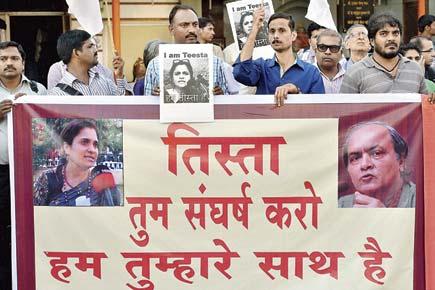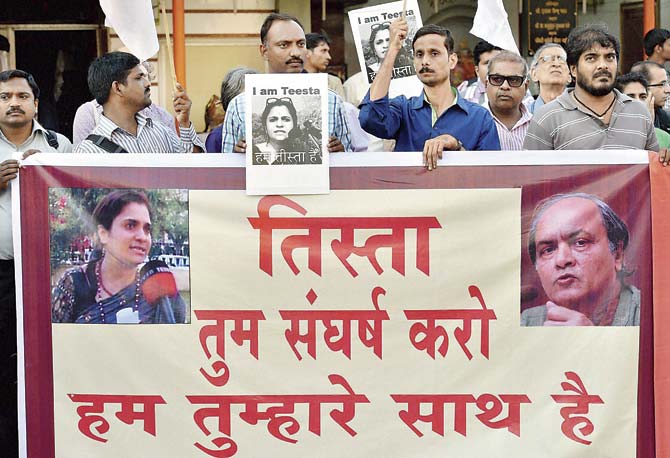The harassment of Teesta Setalvad and Javed Anand by the Gujarat government is hardly surprising. Ever since the two Mumbai-based activists got involved in ensuring justice for the victims of the 2002 Gujarat riots, they have been at the receiving end

 The harassment of Teesta Setalvad and Javed Anand by the Gujarat government is hardly surprising. Ever since the two Mumbai-based activists got involved in ensuring justice for the victims of the 2002 Gujarat riots, they have been at the receiving end. Our society being as complex as it is, there are layers within, upon, above and beyond visible here.
The harassment of Teesta Setalvad and Javed Anand by the Gujarat government is hardly surprising. Ever since the two Mumbai-based activists got involved in ensuring justice for the victims of the 2002 Gujarat riots, they have been at the receiving end. Our society being as complex as it is, there are layers within, upon, above and beyond visible here.
 Mumbaikars stage a protest in support of Teesta Setalvad and Javed Anand, who have been accused of embezzlement. The couple came to national prominence when they fought for the victims of post Babri Masjid demolition riots in Mumbai. Pic/PTI
Mumbaikars stage a protest in support of Teesta Setalvad and Javed Anand, who have been accused of embezzlement. The couple came to national prominence when they fought for the victims of post Babri Masjid demolition riots in Mumbai. Pic/PTI
ADVERTISEMENT
Ever since the Ramjanmabhoomi movement of the 1980s, the word ‘secular’ has become a term of abuse in India. Whatever it means in the rest of the world, when said with a sneer it translates into a person who is only bothered about the rights of India’s religious minorities specifically Muslims and Christians and not about the rights of Hindus. Of course, this is a deliberate and well-thought-out distortion of the word and of those who are not terrified that India is not a Hindu nation.
The Indian idea of secularism adds another dimension. It means, in the official context, not so much a total separation of religion and the state, but a respect for all faiths. In that sense it is the opposite of the French definition of secular. All democracies know that in practice, minority religions have to be protected from the overwhelming might of the majority religion. But because the Sangh Parivar and Hindutva parties have so effectively played upon the idea of victimhood for the Hindu majority, many in India have a tough time understanding secularism. The assassination of Mahatma Gandhi by Nathuram Godse is fraught with this false victimhood as well as hatred of Muslims and secularism.
Moreover, political parties have sunk to low depths of appeasement when it comes to Muslims. The overturning of a Supreme Court judgment which gave maintenance to a poor divorced Muslim woman, Shah Bano, to appease a few Muslim clerics, by the Rajiv Gandhi government is a case in point. Time and again, regressive clerics have had the government’s ear while ordinary Muslims have been discriminated against.
This has only further demonised Muslims as far as the Hindu rightwing are concerned. Sadly, the statistics for most riots in India show that no matter who threw the first stone, it is Muslims who have suffered the most either at the hands of the police or other rioters.
Setalvad and Anand, both former journalists, came to national prominence when they fought for the victims of post-Babri Masjid demolition riots in Mumbai, of 1992 and 1993. Most of those who suffered in the January 1993 riots were Muslims at the hands of mobs led often by the Shiv Sena. No justice was done for victims of those riots and rioters were later elected to power, and police officers who helped rioters were rewarded. This remains one of Mumbai’s biggest shames. But it is the story of most riots in India.
Gujarat 2002 was different. Neither the media nor activists let the matter rest. A televised riot was new for India. Setalvad and Anand soon captured the forefront. This made them unpopular with fellow activists as well as with the Hindutva rightwing but there is no doubt that they fought for justice. But their biggest enemy became the Gujarat government, headed by then chief minister Narendra Modi, now prime minister. Thanks to continued pressure, riot cases got moved out of Gujarat, the Supreme Court made many uncomplimentary remarks about the administration and people were actually tried and convicted. This is a first in this large nation of ours. Obviously, it increased their unpopularity with Hindus steeped in victimhood, people who could not bear the appeasement of Muslims by the Congress and people who find the liberal, protect-minorities-from-majority-pressure to be abhorrent.
Setalvad and Anand have been accused of embezzlement in this particular case. The Supreme Court had earlier asked the Gujarat government to dismiss the charges. This time the apex court has stayed an arrest warrant till February 19. This is not the first time that people have accused the two of irregularities and it won’t be the last. When you take on the high and mighty or fight for a cause, you make enemies, often within your own fraternity.
Ironically, as I write this, the prime minister has made a speech about the importance of the freedom to practice your religion of choice in India. Perhaps further actions in the case against Setalvad and Anand will prove how much of that speech is posturing and how much is meant. No?
Ranjona Banerji is a senior journalist. You can follow her on twitter @ranjona
 Subscribe today by clicking the link and stay updated with the latest news!" Click here!
Subscribe today by clicking the link and stay updated with the latest news!" Click here!







